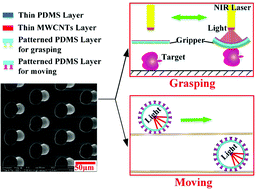Light-driven untethered soft actuators based on biomimetic microstructure arrays†
Abstract
Soft actuators based on smart materials and structures that can perform more diverse tasks skillfully, are being intensively sought. Despite the good progress made in the past few years, locomotion and transportation functionalities of the untethered soft-bodied devices for various natural terrains remain challenging. Inspired by a gecko crawling system, an untethered soft actuator with the abilities of picking up, transporting, and delivering objects controlled by NIR light is proposed. The soft actuator consisting of photo-responsive MWCNTs units and mushroom shaped microstructures, was fabricated by an integrative soft-lithography method with inking and imprinting processes. The integrated MWCNTs unit can convert NIR light irradiation into thermal energy, which can make the body of the soft actuator generate a strong shape deformation intrinsically in a self-contained way, leading to a combined discontinuous and continuous locomotion. Moreover, the integrated mushroom shaped microstructures can also realize grasping and manipulation of the object that was not constrained by the object's shapes and sizes, which was further addressed from experimental and theoretical perspectives. Thus, the combined use of smart materials and structures opens up new research avenues and represents a step forward toward future applications of light-driven untethered soft actuators.



 Please wait while we load your content...
Please wait while we load your content...